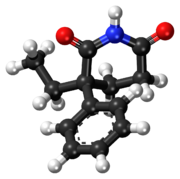Glutethimide
 |
|
 |
|
| Clinical data | |
|---|---|
| Pregnancy category |
|
| Routes of administration |
oral |
| ATC code | |
| Legal status | |
| Legal status |
|
| Pharmacokinetic data | |
| Bioavailability | Variable (Tmax = 1–6 hours) |
| Protein binding | ~50% |
| Metabolism | Extensive hepatic |
| Biological half-life | 8–12 hours |
| Excretion | Renal |
| Identifiers | |
|
|
| CAS Number | |
| PubChem CID | |
| IUPHAR/BPS | |
| DrugBank | |
| ChemSpider | |
| UNII | |
| KEGG | |
| ChEMBL | |
| ECHA InfoCard | 100.000.921 |
| Chemical and physical data | |
| Formula | C13H15NO2 |
| Molar mass | 217.264 g/mol |
| 3D model (Jmol) | |
| Melting point | 84 °C (183 °F) |
| Solubility in water | 999 mg/L (30 °C/86 °F) mg/mL (20 °C) |
|
|
|
|
Glutethimide is a hypnotic sedative that was introduced by Ciba in 1954 as a safe alternative to barbiturates to treat insomnia. Before long, however, it had become clear that glutethimide was just as likely to cause addiction and caused similarly severe withdrawal symptoms. Doriden was the brand-name version of the drug; it was also available under the brand names Elrodorm, Noxyron, Glimid and others. Both the generic and brand-name forms are very rarely prescribed today. Current production levels in the United States (the annual quota for manufacturing imposed by the DEA has been three grams, enough for six Doriden tablets, for a number of years) point to it only being used in small scale research.
Long-term use rebound effects, which resembled those seen in withdrawal, have anecdotally been described in patients who were still taking a stable dose of the drug. The symptoms included delirium, hallucinosis, convulsions and fever.
Glutethimide is a CYP2D6 enzyme inducer. When taken with codeine,"hits", "cibas and codeine ", it enables the body to convert higher amounts of the codeine (higher than the average 5 - 10%) to morphine. The general sedative effect also adds to the effect of the combination. It produces an intense euphoria similar to IV heroin use. The effect was also used clinically, including some research in the 1970s in various countries of using it under carefully monitored circumstances as a form of oral opioid agonist substitution therapy, e.g. as a Substitutionmittel that may be a useful alternative to methadone. The demand for this combination in Philadelphia, Pittsburgh, Newark, NYC, Boston, Baltimore, and surrounding areas of other states and perhaps elsewhere, has led to small-scale clandestine synthesis of glutethimide since 1984, a process that is, like methaqualone (Quaalude) synthesis, somewhat difficult and fraught with potential bad outcomes when less-than-gifted chemists are doing the deed with industrial-grade precursors without adequate quality control. The fact that the simpler clandestine synthesis of other extinct pharmaceutical depressants like ethchlorvynol, methyprylon, or the oldest barbiturates is not reported would seem to point to a high level of motivation surrounding a unique drug, again much like methaqualone. Doriden was discontinued in the US by manufacturers in 1993. Analysis of confiscated glutethimide seems to invariably show the drug or the results of attempted synthesis, whereas purported methaqualone is in a significant minority of cases found to be inert, or contain diphenhydramine or benzodiazepines.
...
Wikipedia
